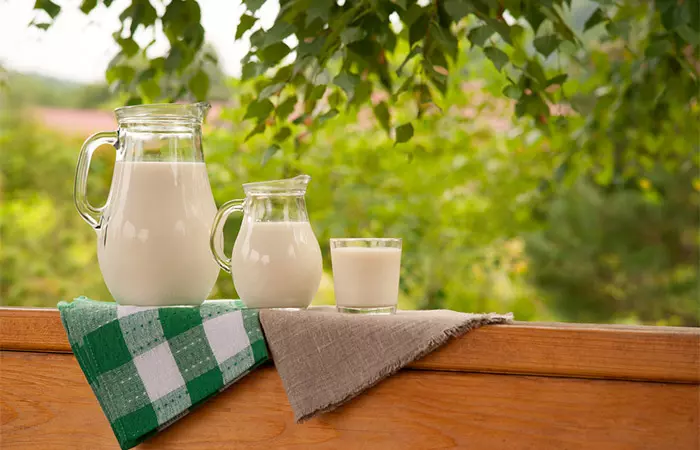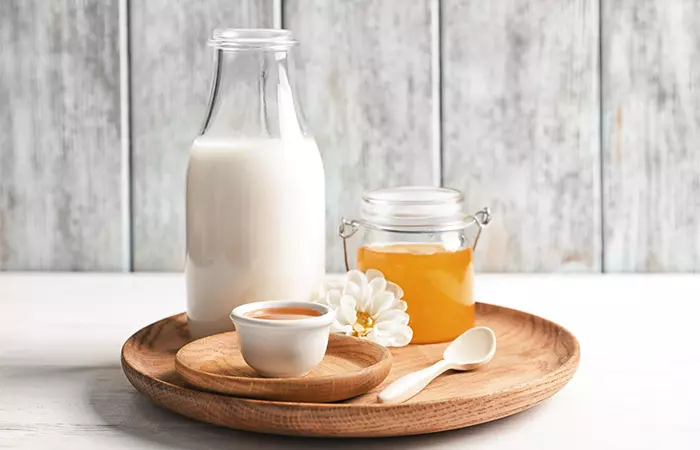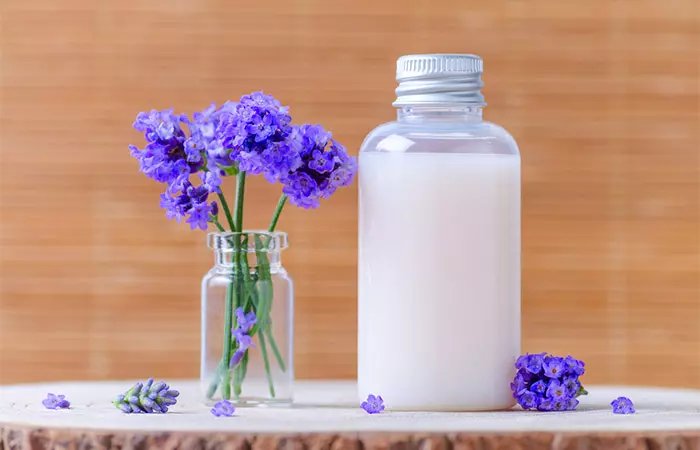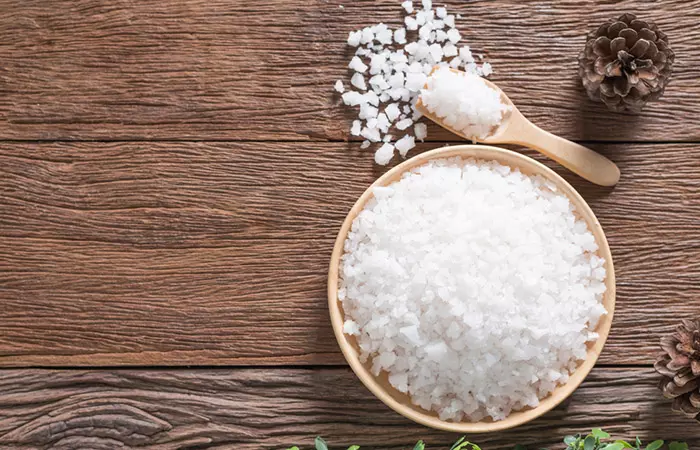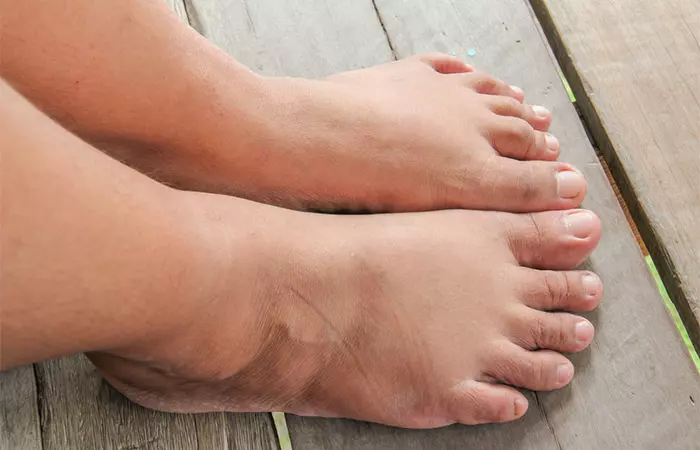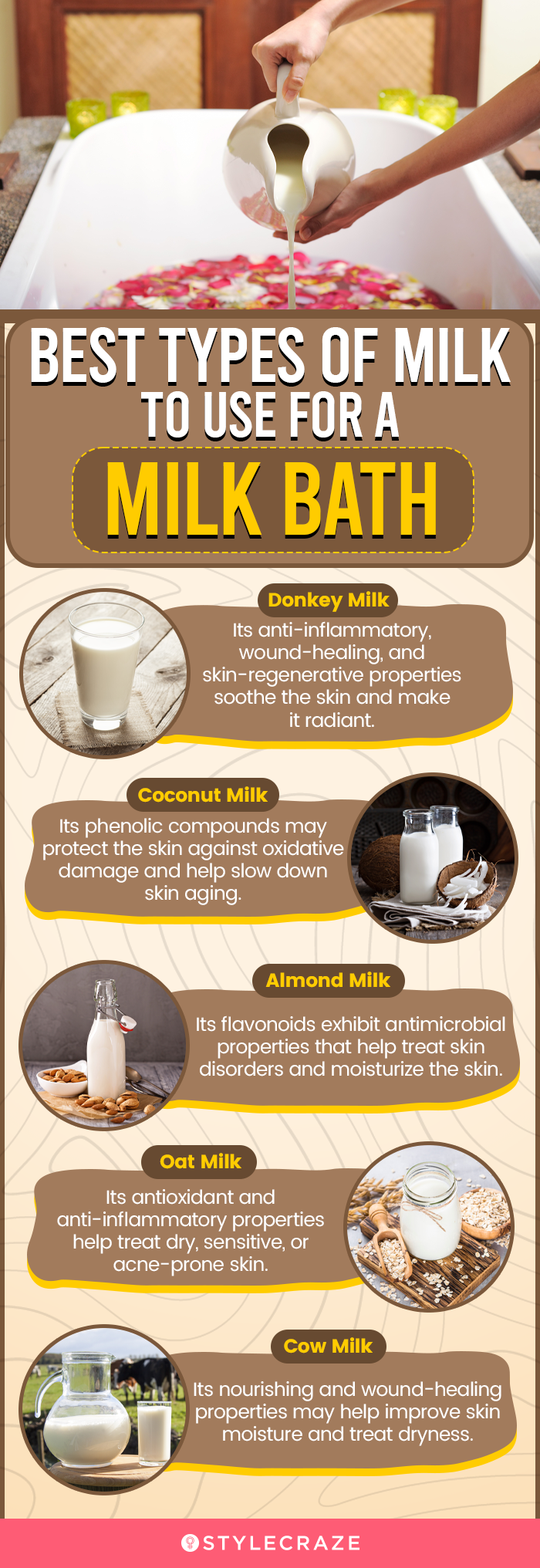What Is A Milk Bath?
A milk bath is a bath made with milk as the main ingredient. There are many nourishing raw milk benefits for the skin. It can soften rough and dry skin and keep it glowing and supple. One can also add flower petals, essential oils, and bath salts to make the milk bath relaxing and rejuvenating. It is the ultimate self-care indulgence for stress relief and pampering. You can use cow milk or even other kinds of milk to make your own milk bath. Taking milk baths is an age-old practice to keep the skin soft. Let’s take a look at its history in the next section.
History Of Milk Baths
The first use of milk baths goes back several centuries. According to some legends, Egyptian queen Cleopatra was the first woman to bathe in goat milk to improve her skin tone. The Roman Empress Poppaea made it a trend after Cleopatra’s death. Later historical accounts talk of other queens and noble ladies indulging in milk baths to achieve softer, youthful, and paler skin. Some African folklore also talk about milk baths as cosmetic as well as healing and disenchantment procedures. In today’s date, we have moved much further from legends and lores and the efficacy of a milk bath has roots in science. Keep reading to learn more.
Which Milk To Use?
Here’s a list of milk from various sources you can use to prepare your milk bath: Donkey Milk: Legend has it that the Egyptian pharaoh, the enigmatic Cleopatra, bathed in donkey milk. The 21st-century scientists have also found a positive effect of applying donkey milk to the skin. Applying creams formulated with donkey milk improved skin hydration and sealed skin moisture, keeping it softer for longer (1). Donkey milk also has anti-inflammatory, wound healing, and skin regenerative properties that help soothe the skin and make it radiant (2). Cow Milk: Cow milk is easily available and has nourishing properties that are good for the skin. Scientists had found wound-healing properties in low-fat cow milk (3). But you can also use full-fat milk if you have very dry skin. Coconut Milk: Coconut milk is obtained from pressing grated coconut flesh. While coconut oil is known for its moisturizing properties, coconut milk is equally effective for the skin. The phenolic compounds in coconut milk may protect skin against oxidative damage and help slow down skin aging (4). Buttermilk: Buttermilk is fermented milk loaded with lactic acid (5). Lactic acid is an alpha hydroxy acid (AHA) popular for exfoliating the skin (6). Almond Milk: Almond milk is obtained from pressed whole almonds. Almond skin is rich in flavonoidsi A group of polyphenolic compounds that occur naturally in plant-based foods rich in antioxidant properties. that have antimicrobial properties (7). The milk could also be a good alternative to those allergic to cow milk. Goat Milk: Goat milk and cow milk are similar in composition. Goat milk, too, helps nourish and hydrate the skin. However, if you are allergic to cow milk, you may want to avoid goat milk as well (8). Oat Milk: Oat milk is made of colloidal oats used in many skin creams and lotions. It has antioxidant and anti-inflammatory properties (8). It is perfect for dry, sensitive, or acne-prone skin.
5 Best DIY Milk Bath Recipes And How To Use
1. Milk And Honey Bath
Take 2 cups of milk of your choice. Mix 4 tablespoons of organic honey with it. Add the mixture to the lukewarm water bath. Soak in it for 30 minutes. Do this twice a week if you have dry skin.
2. Oatmeal Bath
Oatmeal is a great ingredient to exfoliate and also soothe your skin. Learn below how to make an oatmeal bath for moisturized, soft skin.
Take a cup of oatmeal and grind it to a fine powder. Add ½ a cup of warm water and wait for 15 minutes. Stir well and pour the oatmeal colloidal into your lukewarm water bath. Add a generous squeeze of olive oil and 2 drops of lemon essential oil. Soak in it for 30 minutes. Do this two to three times a week if you have callusesi Hard, thickened areas on the skin that often occur on the hands and feet due to friction or excess pressure. and rough skin.
3. Lavender Milk Bath
Take 2 cups of buttermilk. Mix it with ½ a cup of almond milk (or low-fat cow milk). Add 1 teaspoon of baking soda. Mix well. Pour it into a lukewarm water bath. Add 4 drops of lavender essential oil and dried lavender. Soak in it for 30 to 40 minutes. Do this once a week to exfoliate skin/remove dead skin layers.
4. Coconut Milk And Rose Bath
Take 1 cup of coconut milk and pour it into the lukewarm water bath. Add 7 drops of coconut oil and 4 drops of rose essential oil. Scatter some rose petals and soak them for 30 minutes. Do this twice or thrice a week for soft and glowing skin.
5. Goat Milk Bath With Epsom Salt
Take 2 cups of goat milk and mix with ½ a cup of buttermilk. Add it to the lukewarm water bath. Add ¾ cup of Epson salt and 5 drops of neem essential oil. Soak in it for 30 minutes. Do it once a week to even out your skin tone, reduce dark spots, and rejuvenate your skin.
Note: You can use milk powder as well. However, milk powder contains additives that may not be ideal for your skin. Also, all of the milk bath recipes mentioned above can be used with any milk of your choice. Adrianne, a blogger, tried a milk bath and shared her experience in a blog post. She says, “I felt like a million dollars when I was sitting in there! It was amazing. It felt like I was taking the time to do something for myself in a loving and creative way to give myself a little time out…. So anytime you are feeling a bit like some time out, I would highly recommend this as a solution! It will make you feel amazing (i)”. Now that you know how to prepare a milk bath at home, let’s take a quick look at the benefits of a milk bath for skin in the section below. These benefits are based on anecdotal evidence. More research is warranted in this regard.
Milk Bath Benefits For Skin
Moisturizes the skin. Exfoliates the skin Relieves sunburn. Protects the skin from oxidative damage. Reduces fine lines and wrinkles. Smoothens skin texture. Rejuvenates the skin. Helps relax and reduces stress. Improves sleep quality.
Clearly, a relaxing DIY milk bath is easy, quick, and effective on your skin. But does it have any risks or side effects? Read on to find out.
Are There Any Risks?
If you are allergic to any of the milk variants or ingredients mentioned above, avoid use. Rashes, swelling, and itching are signs that you are allergic to any of the ingredients used in the milk bath. Always do a patch test before using the ingredients. Apply a small amount of milk (and other ingredients) at the back of your hand or neck. Wait for 2 hours to see if you develop any allergic reactions. A common concern is whether milk baths can cause yeast infections. Rinsing thoroughly after the bath is generally safe. However, if you are prone to yeast or fungal infections, milk baths may not be ideal for you. Note: Avoid a milk bath if you have oily or acne-prone skin, high fever, or nauseai An urge to vomit, often caused by medications, due to an uneasy feeling in the stomach that does not always lead to vomiting. . Should I rinse after a milk bath? Yes, you should rinse after a milk bath – as leaving milky residue on your skin can cause irritation and unpleasant odors. Hence, rinse with a moisturizing body wash or soap after you are done soaking. Are milk baths good for babies? Apart from breastfeeding, a breastmilk bath for a baby can be beneficial in various ways. The fat content in breast milk can soothe your infant thanks to its incredible moisturizing capabilities. It also retains moisture and helps prevent itching and dryness. How long should you stay in a milk bath? Soak in the milk bathtub for 20-30 minutes to let your skin absorb the goodness of milk and any other ingredients that you may have added. What temperature should a milk bath be? Milk bath should be made at a lukewarm temperature which is between 100 -110 degrees Fahrenheit and (36.5 to 40.5 degrees Celsius). Can a milk bath help with skin conditions like eczema or psoriasis? According to anecdotal evidence, having lukewarm milk baths can help soothe skin conditions such as eczema and psoriasis due to their high moisturizing content. However, there is not enough research to back this claim. Can I use a milk bath if I have sensitive skin? Yes, milk is safe and beneficial for all skin types unless you have an allergic reaction to milk. Can I use a milk bath if I have a milk allergy? In case of lactose allergy, you can use vegan milk made of soy, almond, or coconut milk as they are also highly beneficial for the skin.
Illustration: Best Milk Bath Recipes For Bright Soft And Glowing Skin
Learn how to recreate Cleopatra’s luxurious milk bath at home! Get ready for a DIY Friday and pamper yourself with this historic beauty ritual for a glowing result. Click on the video below!
